Living with Nature Center Flora
- A Botanical Treasure
San Vicente, Ilocos Sur
Dr Abe V Rotor
- Katuray - Queen of Asian Flower Vegetables
- Karimbuaya or Soro-soro is best stuff of lechon baboy and manok
- Food and Nutritional Value of Kulitis, Amaranth, Alugbati, and Talinum
- Some Wild Food Plants: Kalunay, Ngalog...dagiti atap a mulmula a mabalin a kanen wenno sidaen
- Malunggay - Miracle Tropical Tree
- Takip-kuhol (Centella asiatica) - a Panacean home remedy
- A Philippine Indigenous Orchid
- Backyard Garden as Ecological Sanctuary
- Twilight* in the Garden
- Practical Composting
- 15 Common Ornamental Plants at the Living with Nature Center
- Towering Anahaw Palm Trees
- Pictorial Presentation of Plants as they appear on-site at the Living with Nature Center
Katuray - Queen of Asian Flower Vegetables
Dr Abe V Rotor
Katuray in Pilipino and Ilocano is scientifically called Sesbania grandiflora. "Grand flowers" indeed, immaculate white and shy, glisten in the sun. Then as the day wears off, shrivel and fall to the ground, leaving clusters of blossom to open the next day, so in the next, in succession through the amihan season until summer. Pods dangle like chime in place of the flowers. Angie Tobias 18, picks katuray flowers from the tree at the Living with Nature Center, author's residence at San Vicente, Ilocos Sur. Photos taken by the author.
Flowers - in any stage, crescent to fully opened - are picked by hand or with bamboo pole, as often as daily during the flowering season. Young succulent pods, and in other countries young leaves, are also gathered as vegetables cooked into salad, diningding, for stew and broth- perfect with broiled fish, thickened in buridibud (kamote or sweet potato paste). It's a typical dish of Asians, specialty Ilocanos. Move over culinary greats of the Western world. Author with newly harvested unopened katuray blossoms ready to be cooked into salad, cum fresh red tomato, a dash of salt or patis, with option to include sliced shallot or sibuyas tagalog. Try this perfect side dish for lunch and dinner.
Is Sesbania grandiflora, as grand as its name when it comes to its nutritional value? Why not? Take a quick look at this approximate analysis per 100 grams, based on young leaves. Likely not far from flowers (author's note).
A glimpse on this set of data assures confidence on the Health Benefits of Sesbania Grandiflora, as food and natural medicine owing to these properties: Antioxidant, Anti-inflammatory, Anti-Helminthic, Anticoagulant, Hypotensive, and others, and if I may add - Anti-Aging and Relax-Promoting.
- Calories: Around 62 kcal
- Protein: Approximately 7.7 g
- Carbohydrates: Roughly 11.5 g
- Dietary Fiber: About 3.3 g
- Fat: Around 0.5 g
- Vitamin C: Approximately 38 mg (about 63% of the recommended daily intake)
- Vitamin A: Roughly 1130 IU (around 22.5% of the recommended daily intake)
- Calcium: Approximately 130 mg
- Iron: Around 1.2 mg
Author's Note: A variant of Sesbania grandiflora produces shades of pink and purple colors. It produce flowers year round, particularly in the rainy months when the white variety is virtually flowerless. Local folks say colored flowers are more nutritious, likely because of xanthophyll and carotene pigments. Plant katuray on your backyard, and open areas as long as the soil is loamy, relatively fertile, and safe from flood. Stick a branch into the ground and make it grow into a tree. Include katuray among the plants in the Bahay Kubo garden. ~
Acknowledgement: Data from Internet.~
Karimbuaya or Soro-soro is best stuff of lechon baboy and manok
To Ilocanos, no lechon is complete without karimbuaya. When combined with herbs and spices, karimbuaya lends the lechon a distinct taste and aroma. The milky sap of the plant has medicinal properties and helps remove the unpleasant odor of meat and fish.
Dr Abe V Rotor


Cebuanos and Manileños stuff lechon with tanglad or lemongrass,
the Ilocano style is to put in a native plant, karimbuaya.
Not so many people know that karimbuaya or sorosoro (Euphorbia neriifolia) makes an excellent stuff for lechon and relyenong bangos. The mature leaves are chopped tangential and stuffed into the prepared pig to be roasted, so with dressed chicken - and bangus for broiling. It has high oil content in its milky sap. It leaves a pleasant taste and it serves as a salad itself. It has a slight sour taste. Like tanglad, sorosoro removes the characteristic flesh and fishy odor. Add chopped ginger, onion and garlic as may be desired.
One word of caution: The fresh sap of sorosoro may cause irritation of the eye and skin. Wash hands immediately. Better still, use kitchen gloves.
Relyenong bangos with karimbuaya

Adobo with karimbuaya (inquirer.net)
Facts about Karimbuaya or Sorosoro
Philippine Medicinal Plants (Internet)This information is helpful to medicine, pharmacology, botanical research, and to the public in general. It is the intention of this program, Paaralan Bayan sa Himpapawid to encourage the use of natural medicine and food, and to potential scientists to direct their attention to our own indigenous resources as the subject of their study.
Botany
Soro-soro is an erect, shrubby, branched, fleshy, cactus-like plant growing to 2 to 4 meters. Trunk and older branches are grayish and cylindric; medium branches slightly twisted and stout, fleshy, 4- or 5-angled or winged, the younger ones usually 3-winged, the wings lobulate, with a pair of stout, sharp, 2- to 4-millimeter long spines rising from the thickened bases of each leaf or petiole-scar. Leaves, arising from the sides of wings towards the end of the branches, are fleshy, oblong-obovate, 5 to 15 centimeters long; in young plants, longer pointed or blunt at the tip. Cymes are short, solitary in the sinuses, and usually of 3 involucres. Involucres are green or pale yellow, about 6 millimeters in diameter, with the lobes fimbriate.
Distribution
- Cultivated in gardens as a hedge plant.
- Nowhere spontaneous.
- Also occurs in India to Malaya.
Botany
Soro-soro is an erect, shrubby, branched, fleshy, cactus-like plant growing to 2 to 4 meters. Trunk and older branches are grayish and cylindric; medium branches slightly twisted and stout, fleshy, 4- or 5-angled or winged, the younger ones usually 3-winged, the wings lobulate, with a pair of stout, sharp, 2- to 4-millimeter long spines rising from the thickened bases of each leaf or petiole-scar. Leaves, arising from the sides of wings towards the end of the branches, are fleshy, oblong-obovate, 5 to 15 centimeters long; in young plants, longer pointed or blunt at the tip. Cymes are short, solitary in the sinuses, and usually of 3 involucres. Involucres are green or pale yellow, about 6 millimeters in diameter, with the lobes fimbriate.
Distribution
- Cultivated in gardens as a hedge plant.
- Nowhere spontaneous.
- Also occurs in India to Malaya.
Constituents
- Studies have yielded euphorbon, resin, gun caoutchouc, malate of calcium, among others.
- Phytochemical studies have yielded triterpenes like nerifolione, cycloartenol, euphol, euphorbiol, nerifoliene, taraxerol, ß-amyrin among others.
- Fresh latex yields 10.95% solid with 18.32% total resinous matter, and 24.50% and 16.23% of total diterpene and triterpene respectively.
- Phytochemicals yielded steroidal saponin, reducing sugar, tannins, flavonoids in the crude extract.
- Phytochemically analysis of leaves yielded flavonoids, phlobatannins, saponin, tannins, cardenoloids, phenol, and terpenoids. (see study below) (18)
- Study of an ethanol leaf extract isolated a new flavonoid: 2-(3,4-dihydroxy-5-methoxy-phenyl)-3,5-dihydroxy-6,7-dimethoxychromen-4-one. (see study below) (21)
- Study isolated eighteen new diterpenoids, names eurifoloids A-R (1-18) including ingenane (1 and 2), abietane (3-7), isopimarane (8-12) and ent-atisane (13-18) types, along with four known analogues. (see study below) (22)
Properties
- Considered purgative, rubefacient, expectorant.
- Leaves considered diuretic.
- Root is considered antiseptic.
- Latex considered purgative, diuretic, vermifuge and antiasthma.
- Studies have reported cytotoxic, antiarthritic, anti-inflammatory, wound healing and immunomodulatory properties.
Folkloric Uses
- Roots have been used for snake bites.
- Fluid from roasted leaves used for earache.
- The milky juice used for asthma, cough, earache. Also, used as an insecticide.
- Mixed with Margosa oil and applied to limbs in rheumatism.
- Tumeric powder mixed with the juice applied to piles. Thread steeped in the same mixture used for ligaturing external hemorrhoids.
- Milky juice used internally as purgative; rubefacient, externally. Applied to glandular swellings to prevent suppuration.
- Externally, applied to sores, cysts, warts, and calluses.
- Used as a drastic purgative.
- For internal use: decoction or infusion of 10 grams for 1 liter of water, 2-3 cups daily.
- Juice of leaves used for spasmodic asthma.
- Leaves used as diuretic.
- In India, used for bronchitis, tumors, leukoderma, piles, inflammation, fever, earaches, anemia and ulcers.
- In Malaya, used for earache.
- In French Guiana, leaves are heated, squeezed, and the salted sap used for wheezing in babies, colds and stomach upsets. Also used for infected nails, fevers, coughs and diabetes in NW Guyana.
- In Ayurveda, whole plant, leaf and roots used for abdominal complaints, bronchitis, tumors, splenic enlargement, coughs and colds.
Acknowledgement: Philippine Medicinal Plants
Lesson on former Paaralang Bayan sa Himpapawid (People's School on Air) with Ms Melly C Tenorio 738 DZRB 8 to 9 evening class, Monday to Friday
Author's Note: Soro-soro grows in the wild, particularly on uplands and along field borders as long as the soil is well-drained. Farmers, gardeners and old folks readily know this fleshy shrub in the area and may help explain its uses, including its propagation by cutting. It may be cultivated as ornamental plant, and can be potted as well. - avr
- Studies have yielded euphorbon, resin, gun caoutchouc, malate of calcium, among others.
- Phytochemical studies have yielded triterpenes like nerifolione, cycloartenol, euphol, euphorbiol, nerifoliene, taraxerol, ß-amyrin among others.
- Fresh latex yields 10.95% solid with 18.32% total resinous matter, and 24.50% and 16.23% of total diterpene and triterpene respectively.
- Phytochemicals yielded steroidal saponin, reducing sugar, tannins, flavonoids in the crude extract.
- Phytochemically analysis of leaves yielded flavonoids, phlobatannins, saponin, tannins, cardenoloids, phenol, and terpenoids. (see study below) (18)
- Study of an ethanol leaf extract isolated a new flavonoid: 2-(3,4-dihydroxy-5-methoxy-phenyl)-3,5-dihydroxy-6,7-dimethoxychromen-4-one. (see study below) (21)
- Study isolated eighteen new diterpenoids, names eurifoloids A-R (1-18) including ingenane (1 and 2), abietane (3-7), isopimarane (8-12) and ent-atisane (13-18) types, along with four known analogues. (see study below) (22)
Properties
- Considered purgative, rubefacient, expectorant.
- Leaves considered diuretic.
- Root is considered antiseptic.
- Latex considered purgative, diuretic, vermifuge and antiasthma.
- Studies have reported cytotoxic, antiarthritic, anti-inflammatory, wound healing and immunomodulatory properties.
Folkloric Uses
- Roots have been used for snake bites.
- Fluid from roasted leaves used for earache.
- The milky juice used for asthma, cough, earache. Also, used as an insecticide.
- Mixed with Margosa oil and applied to limbs in rheumatism.
- Tumeric powder mixed with the juice applied to piles. Thread steeped in the same mixture used for ligaturing external hemorrhoids.
- Milky juice used internally as purgative; rubefacient, externally. Applied to glandular swellings to prevent suppuration.
- Externally, applied to sores, cysts, warts, and calluses.
- Used as a drastic purgative.
- For internal use: decoction or infusion of 10 grams for 1 liter of water, 2-3 cups daily.
- Juice of leaves used for spasmodic asthma.
- Leaves used as diuretic.
- In India, used for bronchitis, tumors, leukoderma, piles, inflammation, fever, earaches, anemia and ulcers.
- In Malaya, used for earache.
- In French Guiana, leaves are heated, squeezed, and the salted sap used for wheezing in babies, colds and stomach upsets. Also used for infected nails, fevers, coughs and diabetes in NW Guyana.
- In Ayurveda, whole plant, leaf and roots used for abdominal complaints, bronchitis, tumors, splenic enlargement, coughs and colds.
Acknowledgement: Philippine Medicinal Plants
Lesson on former Paaralang Bayan sa Himpapawid (People's School on Air) with Ms Melly C Tenorio 738 DZRB 8 to 9 evening class, Monday to Friday
Author's Note: Soro-soro grows in the wild, particularly on uplands and along field borders as long as the soil is well-drained. Farmers, gardeners and old folks readily know this fleshy shrub in the area and may help explain its uses, including its propagation by cutting. It may be cultivated as ornamental plant, and can be potted as well. - avr
Food and Nutritional Value of Kulitis, Amaranth, Alugbati, and Talinum
A - Kulitis: A super food!B - Chinese Spinach and Spiny SpinachC - 14 Health Benefits of Alugbati LeavesD - Talinum
Researched and Posted by Dr Abe V Rotor in response to queries on wild food vegetables to augment people's food and nutritional requirements, particularly the young generation.
A- Kulitis: A super food!
Acknowledgement with gratitude - avr
Kulitis as we locals call it or the Amaranth, is an edible plant that is easy to grow, grows everywhere and can be found especially in a tropical country like the Philippines. It is an upright annual plant that belongs to the amaranth family and can go as tall as 2.5 meters. According to the Wikipedia, Amaranths as what it is collectively known is a cosmopolitan genus of annual or short-lived perennial plants also known as Amaranthus. Some of its species are grown as ornamental plants, pseudocereals, and leaf vegetables.
Kulitis is mostly grown for its leaves, it is widely used as a component in our dishes. You can be creative in making a dish out of its leaves.
The benefits of this Super Food!It rich in minerals like iron, zinc, magnesium, potassium, phosphorous, copper, and calcium.
- It has an Antioxidant
- Low in Calories
- High in Dietary Fiber
- Rich in Vitamins A, C, K,
- Rich in B Vitamins
- Gluten Free
- Rich in Protein
- Rich in Lysine
- Reduces Bad cholesterol
Better grow your own pot or bed of Kulitis to have a ready supply of ingredients to include it on your dishes, then ingest and have all of these nutrients for our health and wellness. Also, growing your own pot of Kulitis ensures you of consuming organic produce and free of commercial pesticides that can do harm to our health.
B - Chinese Spinach and Spiny Spinach
Amaranthus dubius and Amaranthus spinosus
LEFT PHOTO, Amaranthus dubius, the red spinach, Chinese spinach, spleen amaranth, hon-toi-moi, yin choy, hsien tsai, or Arai keerai belongs to the economically important family Amaranthaceae, native to South America, Mexico, and the West Indies, however; it is widely introduced throughout the world. The species occurs locally in France and Germany and is naturalized or invasive in tropical and subtropical regions of the United States (Florida and Hawaii), Africa, Asia, Australia and the Pacific. Usually it grows to a size of 80–120 centimeters (31–47 in). It has both green and red varieties, as well as some with mixed colors. The green variety is practically indistinguishable from Amaranthus viridis. Amaranthus dubius is very close genetically to Amaranthus spinosus (RIGHT PHOTO) and other Amaranthus species. This species is valued as a leafy vegetable throughout South and Southeast Asia and also in Africa. It is commonly cooked with onions, tomatoes and peanut sauce.
NOTE: Amaranthus spinosus is gathered in the field as vegetable in its seedling stage, before the spines develop and become tough.
C - 14 Health Benefits of Alugbati Leaves
– Philippine Super Food
rachelleignacio (Internet)Acknowledgement with gratitude - avr
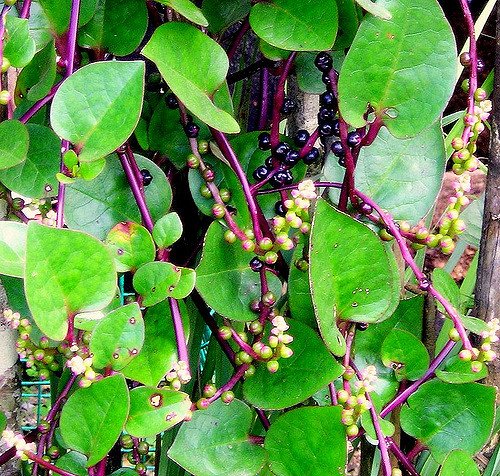 Alugbati leaves are also known as Malabar Spinach. It is named after the place where it is found. Malabar is a place in Philippine. Although people call it spinach, it is actually not spinach at all.
Alugbati leaves are also known as Malabar Spinach. It is named after the place where it is found. Malabar is a place in Philippine. Although people call it spinach, it is actually not spinach at all.Nutritional information of alugbati leaves
Just like the other green vegetable, this leaves also have high level of iron. However, it also has ample of nutrition which is beneficial for health. To make it detail, the nutritional information of each 100 grams of alugbati leaves are listed as follow.
Calories 19Carbohydrate 3.4 grFat 0.3 grProtein 1.8 grVitamin A 160%Magnesium 16%Vitamin C 170%Iron 6%Vitamin B6 10%Sodium 24 mgPotassium 510 mgCalcium 10%
Health benefits of alugbati leaves
So, let’s just call it alugbati leaves. This is heart shaped leaves which grow along in the purple stem. Alugbati is a succulent plant. It can be found in tropical Asia and Africa countries.
. Control blood pressure
. Prevent constipation
. Relieve ulcer
. Prevent cancer
. Prevent anemia
. Lose weight
. Release toxins
. Improve eyesight
. Boost immunity
. Soften skin
. Anti aging property
. Reduce swelling
. Good for pregnancy
. Help you sleep
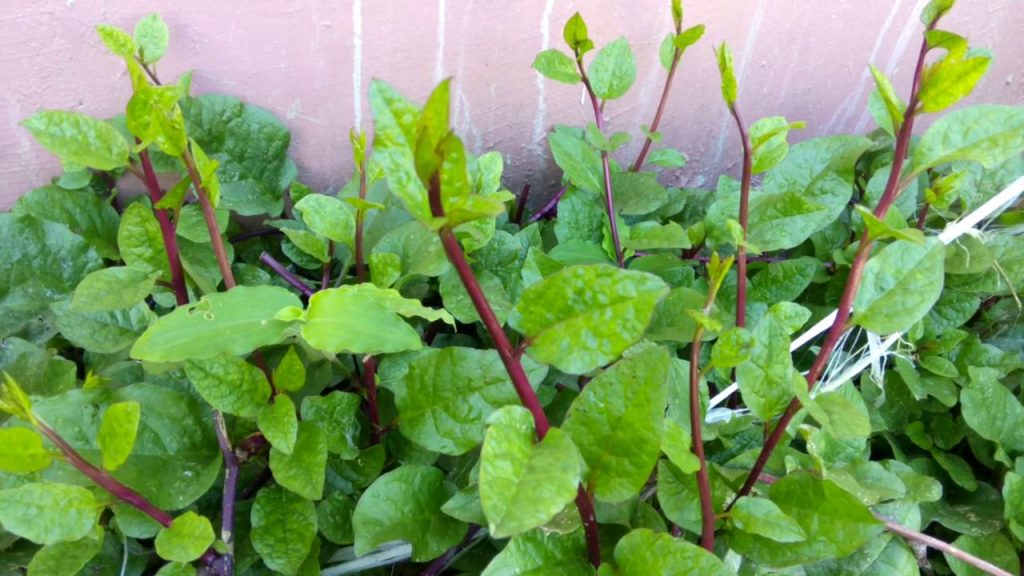.jpg)
Recommendation in consuming alugbati leaves
People in some Asia countries commonly use this leaves as vegetable to any kind of cuisine. However, the selection is also important step before we cook the leaves. To choose the perfect leaves, make sure to choose the fresh leaves with shiny leaves and firm stems. Avoid sunken, dry and discolored leaves.
In preparing the leaves, don’t forget to wash the leaves in cold running water to get health benefits of alugbati leaves. We can include some soft stem of it. Just like health benefits of Water Spinach , alugbati leaves produce some water when it is cooked. In addition, it produces thick glue like consistency to the cooking. Therefore, it is good to include this tender leaves into soup, stew, or stir fry vegetable.
image source #colorchallenge#life#nature#philippines
5 years ago in #food by rachelleignacio (60)
People in some Asia countries commonly use this leaves as vegetable to any kind of cuisine. However, the selection is also important step before we cook the leaves. To choose the perfect leaves, make sure to choose the fresh leaves with shiny leaves and firm stems. Avoid sunken, dry and discolored leaves.
In preparing the leaves, don’t forget to wash the leaves in cold running water to get health benefits of alugbati leaves. We can include some soft stem of it. Just like health benefits of Water Spinach , alugbati leaves produce some water when it is cooked. In addition, it produces thick glue like consistency to the cooking. Therefore, it is good to include this tender leaves into soup, stew, or stir fry vegetable.
image source #colorchallenge#life#nature#philippines
5 years ago in #food by rachelleignacio (60)
D. Talinum
Talinum planted on compost bag at the Living with Nature Center,
San Vicente, Ilocos Sur
Laxative effects: Waterleaf is packed with essential antioxidants and soluble fibres that act as mild laxatives. It is, therefore, recommended for use when constipation is an issue. Regulates blood sugar Level: Joshua et al. (2012) reported that Talinum triangulare is essential for managing diabetes mellitus
References: Internet, Living with Folk Wisdom, AV Rotor (UST}, Living with Nature, AVRotor (UST), Living with Nature in Our Times, AVRotor (UST), former Paaralang Bayan sa Himpapawid (People's School on Air) DZRB
Some Wild Food Plants: Kalunay, Ngalog...dagiti atap a mulmula a mabalin a kanen wenno sidaen
Dr Abe V Rotor
 Wild ampalaya, eggplant, native patani and alukong (himbaba-o)
Wild ampalaya, eggplant, native patani and alukong (himbaba-o)Fortunately Ilocano has remained vigorous and progressive. This is principally because of one distinct trait of the Ilocano - his loyalty to his language, and pride he carries with it as Ilocano. He carries it across the oceans and plant it in the community in which he is integrated. He is so regionalistic that he influences people around him, more than the other way around.
No only that, Ilokano is integrated with culture like horse and carriage. No language can best describe pinakbet, basi, Biag ni Lam-ang, Angalo, Apo Lakay, and a thousand-and-one indigenous terms that describe native practices and beliefs, historical places and events, heritage and values of this proud regional race.
This article and other articles in Ilokano which I wrote in this blog were inspired by Dr Nicholas L. Rosal, author of Understanding an Exotic Language - Ilokano (1982). His work explores the significance of the syntactical structures and grammatical forms of Ilokano, a language spoken by (more than) three million Filipinos and recognized among the eight Philippine languages amidst eighty-some dialects. I had the opportunity to visit Dr. Rosal many years ago in his residence in New Jersey where he and his family reside. Dr. Rosal taught graduate education courses at Seton Hall University, and became director of the Perth Amboy Adult Bilingual High School, one of its kind in New Jersey and elsewhere in the world.
I invite the Ilocano reader to interpret this article and share it with fellow Ilocanos and non-Ilocanos as well.
-----------------------------------------------------------------------
Adu dagiti atap a mulmula a mabalin a kanen wenno sidaen. Ammo da apongtayo daytoy.
Ti saluyot (Corchorus olitorius), gagangay laengen ta saanen a kas idi a dagiti laeng agtubo iti babaet dagiti mula a tarong ken kamatis ti tarayen a kettelen. Ita, addan dagiti agmulmula iti ilakoda.
Adda met dagiti mabalin a kanen a ganggannaet iti imatang wenno di ammo a kanen ti adu kadatayo ita. Kas pagarigan, ti nami (Dioscorea hispida) wenno karut. Makasabidong daytoy ngem ammo dagidi apongtayo nga ikkaten ti sabidongna sa lutuen (salapusopan) a kanenda.
Idi met panawen ti Maikadua a Gubat, napilitan dagiti tattao a mangan kadagiti dati a dida kankanen a kas iti bunel ti saba (nangruna ti balayang) ken magey tapno mapedped ti bisinda. Adda met dagiti mangmangan iti bunel ti wild taro wenno aba a paminduaenna ti tayag ti tao ti tayagan dagiti lupakna. Pispisienda daytoy sa lingtaenda iti mabayag tapno di makaulaw.
Kadagupan dagiti atap a mula a mabalin a kanen, adun ti dandani maungaw. Maigapu daytoy iti panangipamaysatayo iti panagpatanor kadagiti mula a gagangayen nga am-ammo dagiti aggatgatang, dagiti nakairuamanen ti dilatayo ti ramanda.
Ita, aglatlatak manen dagiti makmakan a kunkunada nga organic—saan laeng a ditoy Filipinas, no di pay ket iti ballasiw-taaw a kas idiay America— adu manen ti maibaw-ing ti imatangna kadagitoy a naipakpakanigid a mula. Kayat ngamin a liklikan ita dagiti tattao dagiti makmakan a narnek iti abuno ken pasuyot iti pestisidio, wenno dagiti mula a kunada a GMO (genetically modified organism).
Isu a makitkita manen kadagiti tiendaan dagiti lako a ngalog (Portulaca), dampalit, katuday, papait, kalunay wenno kuantong, balleba wenno ballaiba (Vallisneria), tartarabang, talinum, alugbati, kumpitis, rosil, gulasiman, atap a paria wenno ti aw-awaganda iti simmaron, ken alukon. Adda payen aglako iti bunga ti singkamas. Awan met ngata ti makitkitayo a mapaspasuyotan iti insektisidio a bunga ti singkamas, ania?
* * *
Okeyka, Apong!
Dagiti Tawid a Sirib ken AdalColumn of Dr Abercio Valdez Rotor, Ph.D.
Bannawag Magazine
Malunggay - Miracle Tropical Tree
Dr Abe V Rotor
 A sapling of Malunggay (Moringa oleifera) propagated from cutting. This tropical tree vegetable grows up to twenty years or more on well-drained loam soil. No home is without malunggay in the province. Leaves, flowers, young and mature pods are made into various recipes. The tree needs no attention virtually - no spraying, fertilization, and it is self regenerating after a typhoon or heavy pruning. It grows on borders, fences and hedges and becomes part of the landscape.
A sapling of Malunggay (Moringa oleifera) propagated from cutting. This tropical tree vegetable grows up to twenty years or more on well-drained loam soil. No home is without malunggay in the province. Leaves, flowers, young and mature pods are made into various recipes. The tree needs no attention virtually - no spraying, fertilization, and it is self regenerating after a typhoon or heavy pruning. It grows on borders, fences and hedges and becomes part of the landscape.

pieces.

Malunggay pod is cooked into
bulanglang or diningding. To thicken the soup add kamote (sweet potato) tuber sliced or in cubes, which is first cooked and softened to paste. The cleaned pod is then added, followed by sahog, say broiled or fried tilapia, or pork, as may be preferred.
What nutrients do we get from malunggay? Malunggay pod is skinned, and cut into pieces, cooked into dinengdeng, with kamote (buridibud) and alukong.* (PHOTO) Broiled tilapia or bangos is excellent sahug.
Here is a comparison of the food value of the fresh leaves versus green pods, in percent. (Marañon and Hermano, Useful Plants of the Philippines)
• Proteins - 7.30 vs 7.29
• Carbohydrates - 11.04 vs 2.61
• Fats - 1.10 vs 0.16
• Crude Fiber - 1.75 vs 0.76
• Phosphorus (P2 O 5) - 0.24 vs 0.19
• Calcium (CaO) - 0.72 vs 0.01
• Iron (Fe2O3) - 0.108 vs 0.0005
Owing to these properties and other uses, rural folks regard malunggay a “miracle tree.” Take for example the following uses.
• The root has a taste somewhat like that of horse-radish, and in India it is eaten as a substitute to it.• Ben oil extracted from the seed is used for salad and culinary purposes, and also as illuminant.• Mature seeds have antibacterial and flocculants properties that render drinking water safe and clear.
From these data, it is no wonder malunggay is highly recommended by doctors and nutritionists for both children and adults, particularly to nursing mothers and the convalescents. Make it a family habit to serve a dish of malunggay regularly. ~
-----------
*Alukong (Ilk) or Himbaba-o (Tag) is a favorite vegetable for dinengdeng or bulanglang. It is actually the staminate or male flower of a large tree.
. In observance of World Food Day October 16, 2016
. Lesson on former Paaralang Bayan sa Himpapawid (People's School-on-Air) with Ms Melly C Tenorio 738 DZRB AM Band, 8 to 9 evening class Monday to Friday
Takip-kuhol (Centella asiatica)
- a Panacean home remedy
Dr Abe V Rotor
Takip-kuhol (Centella asiatica) - a Panacean home remedy
Takip kuhol which means literally the operculum of gastropods or snails, grows wild, often as weeds in the garden and field where the soil is moderately damp. It is easy to raise it in pots such as this sample (At home, QC)
Takip kuhol is a highly regarded plant of many uses; in fact it has a panacean reputation in folk medicine. Ask an herbolario, a bona fide housewife, or a village elderly. And they would say, "Takip kuhol lang ang kailangan diyan." (All you need is Centella asiatica, the scientific name of the plant.)
Of course they are talking about common ailments, referring to ordinary colds, fever, flu, skin infection, sore throat, boil (pigsa), headache, constipation, blows and bruises. The herbal may be prepared as decoction (boiled) or fresh. It may be toasted and served as tea or infusion.* For external use, the leaves are crushed and applied as ointment or liniment with Vaseline or coconut oil.
In a research conducted, takip-kuhol leaf extract was found to be an antibacterial agent against three common infectious bacteria, which explains the efficacy on the plant against infectious diseases which these bacteria cause.
· Escherichia coli, a type of bacteria that lives in our intestines.
Most types of E. coli are harmless. However, some types can
make us sick and cause diarrhea.· Staphylococcus aureus, a bacterium frequently found in the
human respiratory tract and on the skin.· Salmonella enterica. Salmonellosis is an infection with bacteria
called Salmonella. Most persons infected with Salmonella develop
diarrhea, fever, and abdominal cramps
Pure extract of Takip-kuhol leaves is effective against Escherichia coli, Staphylococcus aureus and Salmonella enteritidis. Boiled extract is not as effective, especially against E coli.
Panacea is often referred to as cure-all, which is mythological, Panacea being the Greek goddess of healing. There is no single remedy for all ailments. As a caution, takip-kuhol should not be used as a prescription to serious ailments and diseases, specially those that require medical attention.~
Botany of Takip-kuholFamily: ApiaceaeScientific name: Centella asiaticaa (Linn) UrbSynonym: Hydrocotyle asiaticaa LinnOther common names: Gotu kola, hydrocotyle, Indian pennywort
Illustrated life cycle of Centella asiatica; plant in bloom
Traditional Use: Crushed leaves aare commonly consumed by Sri Lankans as salad or hot beverage. More recently the herb acquired a considerable reputation as an aphrodisiac, a agent that stimulates sexual vitality.
Phytochemicals: ALKALOIDS, ALKALOID CHLORIDES, ASIATICOSIDE, BRAHMINOSIDE, BRAMOSIDE, CALCIUM, DEXTROSE, Fe2O3, MADECASSOSIDE, MUCILAGE, PECTIN, P2O5, RESIN, SAPONIN, TANNIN, VELLARINE, VITAMIN B
Other properties/actions: Hypotensive, longevity promoter, sclerotic, stimulant, tonic, treatment for abscesses, dysentery, fevers, headaches, high blood pressure, jaundice, leprosy, mental troubles, nervous disorders, rheumatism, skin eruptions, ulcer.
Plant Description: Slended, creeping plant with stems that root at nodes. Leaves are rounded to kidney- or heart-shaped at the base. Flowers are 3 sessile. Fruits are minute, ovoid, white or green and reticulate.
- Reference: Rotor AV, De Castro D and RM Del Rosario, Philippine Herbs to Increase Sexual Vitality
*Infusion is the process of extracting chemical compounds or flavors from plant material in a solvent such as water, oil or alcohol, by allowing the material to remain suspended in the solvent over time (a process often called steeping). An infusion is also the name for the resultant liquid. The process of infusion is distinct from decoction, which involves boiling the plant material, or percolation, in which the water passes through the material as in a coffeemaker. Wikipedia
A Philippine Indigenous Orchid
(Cymbidium Finlaysonianum)
Dr Abe V Rotor
It is a native orchid. I found it clinging on a fallen branch of a big tree in Mt. Makiling forest. Being an epiphyte I tied it on the trunk of a talisay (Terminalia catappa) tree. It was not difficult for the new transplant to find a new home - in our home.
Among the five Cymbidium species, C. Finlaysonianum is the most widely distributed throughout the Malaysian area, It was collected by Finlayson in Chin-China in the nineteth century. It was dedicated to him by Lindley, who originally described the plant in 1832. There is also a close relative, Cymbidium atropurpureum, its name taken from its dark purple flowers. Because of its closeness to C. Finlaysonianum in all morphological aspects, botanists consider it to be a variety of the latter.
The leaves of this species are leathery and coarse, 35 to 40 inches long and 1.5 to 2.5 inches wide. The raceme is pendulous, about two to four feet long and many-flowered. The flowers are two inches in diameter, sepals and petals rather narrow, long, and colored dull tawny yellow with a reddish-brown median line. The labellum is three-lobed, the center lobe being whitish with a yellow disk and purple-crimson apical spot.
Unlike most domesticated and hybrid orchids that bloom any time and for long periods, I observed that this wild orchid is sensitive to photoperiodism. It blooms usually in summer - in March and April - and the flowers last about two weeks. I like the characteristic mild fragrance specially in early morning.
Orchids are among the easiest plants to propagate, vegetatively that is, either by tillers (shoots), or by tissue culture, a specialized laboratory procedure. This compensates for the extreme difficulty in propagation by seeds. The seeds of orchids are the most difficult to germinate. Even if they do, survival rate is very nil. It is because the viability of orchid seeds is very short and difficult to monitor.
I have yet to succeed in germinating the seeds of C Finlaysonianum. Even if I fail, I am delighted to have a wild orchid luxuriantly growing in my home - its home. ~~
References: Philippine Orchids by Reg S Davis and Mona Lisa Steiner[
Living with Nature in Our Times Copyright 2007 Abercio V Rotor and University of Santo Tomas
Backyard Garden as Ecological Sanctuary
"One day I found leisure watching a spider span a huge web - a beautiful tapestry!" avr.
Dr Abe V Rotor
Everyday birds from the watershed come to our garden. They perch on the trees singing melodious songs for hours. They are a gentle alarm clock and at sunset draw out the tension of the day and put it to rest. For some 25 years now with the children spending their childhood and adolescence, memories come spontaneously alive at nature’s presence. We look for nature, but nature comes to you, too. We can make the backyard a sanctuary of living things. It becomes a corner of Eden so to speak, in the inner eyes of the English poet John Milton, in the soul searching music of Beethoven, and in the quasi-spiritual reverence for life of John Muir and Also Leopold.
What makes an ecological garden? Here are some guidelines.
Let nature do the arranging of the plants – their kinds, growing habits, seasonal occurrence, and niches. This principle must prevail over our plan to make the garden Italian or Japanese in which man dictates the plan of the garden.
The garden serves six important functions.
Orchard-garden in our ancestral home, San Vicente, Ilocos Sur
Everyday birds from the watershed come to our garden. They perch on the trees singing melodious songs for hours. They are a gentle alarm clock and at sunset draw out the tension of the day and put it to rest. For some 25 years now with the children spending their childhood and adolescence, memories come spontaneously alive at nature’s presence. We look for nature, but nature comes to you, too. We can make the backyard a sanctuary of living things. It becomes a corner of Eden so to speak, in the inner eyes of the English poet John Milton, in the soul searching music of Beethoven, and in the quasi-spiritual reverence for life of John Muir and Also Leopold.
What makes an ecological garden? Here are some guidelines.
Let nature do the arranging of the plants – their kinds, growing habits, seasonal occurrence, and niches. This principle must prevail over our plan to make the garden Italian or Japanese in which man dictates the plan of the garden.
The garden serves six important functions.
• Cooling effect. A 10-year old acacia tree (PHOTO Internet) for example, has the capacity to provide the cooling power of ten 10Hp air conditioning units. Trees make a huge umbrella that protects us from heat stroke.
• Windbreak. Trees, especially if planted in group or rows, and in combination of other plants, can withstand the strength of strong wind.
• Sound barrier. Foliage serves as acoustic, absorbing echoes, and filtering unwanted sound waves, and resonating the good ones like in an amphitheater.
• Dust filter. Plants eliminate particles in the air with their leaves trapping and moistening them with transpired water, thus sending them back to the soil.
• Radiation filter. Plants serve as buffer against ultraviolet rays as well as cosmic rays. So with other forms of radiation, visible and invisible, that are harmful to health and environment.
• Color filter. Plants act like a giant prism, but unlike the lens, colors are pooled into a common color - green – the coolest of all colors, neutral and soothing to the eyes and other senses.
A garden is not a garden if it does not smell like one. Ilang-ilang exudes sweet scent throughout the year. It is sweetest in early morning and evening, and a soft breeze spreads the scent in the neighborhood. The best scents in the garden come from Eucalyptus, binunga (samat) PHOTO Internet , pandan mabango, sweet basil, roses, rosal, dama de noche, and of course, sampaguita.
One day I found leisure watching a spider span a huge web. It is a giant spider called Haring Gagamba working of a tapestry. I remember the story of the Irish hero, Robert The Bruce, watch a spider making a web. The spider failed in several attempts to construct the primary frame. It gave the downhearted hero the heart to win back the crown.
In the garden, there are unceasing battles between and among living things. . Birds eat on caterpillar, frogs have their fill on flies, dragonflies hover and devour flying gnats, spiders entrap grasshoppers, preying mantis prey on unwary insects. I have observed hantik or green tree ants (Oecepalla smaragdina) build nest in the upper branches of talisay. Their colony is closely knit and their nest is an architectural wonder. The green leaves are sewed together by the workers stroking the larvae to secrete a sticky substance that dries like paper. The larva is actually carried by an adult like a tube of epoxy as other workers hold the leaves to be sewed together. These ants attack as an army that even a caterpillar is subdued in an instant and sooner or later cut into pieces which the ants carry to their nest to feed the colony.
Yet in the same spot ants and termites live together. It is a demonstration on how two different niches work, bounded by biological rules. The ant colony stays above ground to up the foliage, while the termites in an anthill called punso. Yes, the termites – they are an engineering genius. They build their mound at the foot of the big talisay tree – then, when dug out move to another place overnight, and when we think they are no longer there, it is likely that they are virtually sleeping with us inside the house. And true, we discovered a colony of termite in an apparador, and another in a roof beam. It is here that man turn against a destructive organism.
Plants kill other plants to maintain their boundaries. They abort germinating seeds even of their kind that become threat to their existence. Allelopathy is a phenomenon plants harm one another, in order to enhance success in competition for sunlight, nutrients, water and space. Plants secrete chemicals in their roots, stems, and leaves. To illustrate, we have a ten-year old malunggay that is slowly being choked by coconut and binuga tree (Macaranga tenarius). All the cultivars of mayana I planted were lost, due to inter competition, and then they were overrun by carabao grass. Ube (Dioscorea alata) takes advantage with its viny habit virtually leaping out into space, its leaves covering much of the trees and wall, then after rainy season it all disappears leaving but a five-kilo tuber ensconced in the soft earth and mulch.
But wonder what those plants are clinging on the trunk of trees. These are epiphytes, a relationship called commensalisms. The epiphytes benefit from their tree host. They gain foothold and elevation to reach sunlight without harming their host. We have a talisay tree that carries on its trunk a cluster of native orchid that blooms with a dangling inflorescence appearing like giant leis.
Lest a garden is misunderstood as purely aesthetic and ecological. One coconut tree can provide an ample supply of walis tingting, sweets, coconut milk (gata), husk for the orchids, firewood, and buko, but we love this tree of life most whenever birds build their nest on top and unfold a primitive sense of family love and care.
At night bats come and gather the ripe fleshy fruits of talisay (Terminalia catappa) PHOTO, and would accidentally drop a fruit or two hitting the roof of our house, and if we are not aware of the cause, we would attribute it to a prankster – or a spirit who wants to disturb our sleep.
Do you believe in spontaneous generation? Saluyot, amaranth, kamkamote, Portulaca – these and other wild growing vegetables pop out of the ground following the first heavy rains in May, and believe it, after two weeks they are ready for the kitchen. Their succulent leaves and stems are rich in vitamins and minerals. But we do not gather the plants entirely; we simply trim down the leaves leaving the plant to reach maturity. How these wild species survive the dry months is a proof of their sturdiness which guided their successful evolution.
How high can a tree reach? Well, our ilang-ilang (PHOTO) grew and grew and grew, and then one day a strong wind decapitated it. Then the upper branches dried up one by one until the tree has but a bunch of low branches. We know that there is always limit to growth, and the very same factors that favored it also created its liabilities. I am reminded of the syndrome of bigness whether it be an animal or tree or business. We call this Dinosaur Syndrome. ~
''Tranquility, serenity, and beauty of nature taught me how to find happiness in life and in the silence of eternity.'' - Debasish Mridha
Twilight* in the Garden
Living with Nature Center
San Vicente, Ilocos Sur
"Twilight is the soft glowing light from the sky when the sun is below the horizon, caused by the refraction and scattering of the sun's rays from the atmosphere."
Dr Abe V Rotor
Twilight is the time when the color green begins to be perceived as black in a gradual transition until darkness engulfs all colors and ultimately all the light over the place as the sky loses its glow, ultimately becoming dark, as the stars slowly emerge.
Twilight is the emergence of crepuscular creatures, active during this narrow time frame - the ephemeral transition of day and night - exemplified by the skipper, relative of the butterfly and moth which are respectively diurnal and nocturnal.
Twilight is a time leguminous plants, commonly known as beans but which include trees like the acacia and tamarind "sleep", so to speak, their leaves automatically folding and drooping as dictated by nature's built-in mechanism called pulvinus.
Twilight is a time the garden is most fragrant - ilang-ilang, source of one of the most fragrant perfumes here and abroad; sampaquita, the Philippine national flower; dama de noche, enchanted plant rich in fairy tales, bedtime and folk stories.
Twilight is a time nocturnal creatures like bats, owls, moths, and many others 'wake up" from their abode and hiding places in search for food, mate, company, and other needs, keeping sentry and creating a unique world of their own in the night. - AV Rotor
Twilight is a time white is purest, standout of all colors, emerging from some dark corners in the garden, from the flowers of pandakaki, rosal, native santan, sampaguita, kangkong - reflecting the glow of the sky in subdued radiance, immaculate and naïve.
“Sunsets and the twilight often inspire us. As nature changes through periods like dusk to dawn, we can refresh our minds. This is why you’ll see many photos on social media displaying individual views of that period between day and night. You’re in the right place for calming and inspiring dusk quotes.”
Twilight is a time the icons in the garden - Rizal, Aguinaldo, Mama Mary, Apo Baket (likeness of a grandmother), and the Unknown Yaya (Nanny) - "glow" in a kind of reverence and glory for their being models for their deeds and unique achievements. to man and society,
“I like the night. Without the dark, we’d never see the stars.” – Stephenie Meyer
Twilight is a time to pray the Angelus, prayer of thanksgiving for the day, and prayer in preparation for the night in sweet surrender to all cares and worries, a time of reflection and meditation, and a time to gather the family together.
“The hours I spend with you I look upon as sort of a perfumed garden, a dim twilight, and a fountain singing to it. You and you alone make me feel that I am alive. Other men it is said have seen angels, but I have seen thee and thou art enough.” - George Edward Moore
Twilight is a time to be at home particularly in the countryside; old folks would warn of the kibbaan (bad spirit) lurking, reminding children to be home before dark, to join the family in supper and prayer, and for the whole family to have a peaceful night.
Twilight is a time to examine our ways of treating Mother Nature as we reflect on one hand the biblical Lost Paradise, and on the other, how that Garden may be "regained" in some small corner by own own hands, by being true to "Man's Treaty with Nature." - AVRotor
“Twilight - a time of pause when nature changes her guard. All living things would fade and die from too much light or too much dark, if twilight were not.” – Howard Thurman
------------------------------
*Twilight is the period between sunset and dusk. During twilight there is still light in the sky. There are three types of twilight: civil, nautical and astronomical. Dusk is the point when the sun is at 18 degrees below the horizon and there is no longer any sunlight in the sky.
Karamay (Ilk), Karmai or Iba
- The "Acid" Fruit
Latin: Cicca acida (Linn.) Merr. Family Euphorbiaceae
Dr Abe V Rotor
A bountiful harvest of Karmai (Karamay Ilk), Sn Vicente, Ilocos Sur
 You don't have to climb the tree, just shake a branch - or the small tree - and pronto, you have a shirt- or skirtful of this fruit curiously known by its scientific name - Cicca acida, which means in Latin, acidic seed membrane. It got a stone hard core surrounded with thick cartilaginous flesh that is very sour. In botany they call this kind of fruit, drupe. And would you think you can have your fill even with the ripest pick?
You don't have to climb the tree, just shake a branch - or the small tree - and pronto, you have a shirt- or skirtful of this fruit curiously known by its scientific name - Cicca acida, which means in Latin, acidic seed membrane. It got a stone hard core surrounded with thick cartilaginous flesh that is very sour. In botany they call this kind of fruit, drupe. And would you think you can have your fill even with the ripest pick? Kids we were in our time, would simply relish the fruit, fresh or pickled. Our folks would join cautioning us not to eat too much especially with empty stomach. But in the process, they compete for the choice sizes leaving the small and immature ones. You see, when you harvest, ripe and young fruits fall at the same time to a waiting inverted umbrella, or a stretched blanket, unless you handpick only the ripe ones - which is tedious. When pickled with sukang Iloko (native Ilocos vinegar) and salt, all sizes, mature and immature, become grossly inviting.
What do you get from karmai? It may be poor in food value but it contains appreciable amounts of minerals and vitamins the body may need. Per 100 g of edible portion examined, 92 percent is water. It is low in protein (0.155 g), fat (0,52 g), fiber (0.8 g). It got some calcium (5.4 mg), phosphorus (17.9 mg). iron (3.25 mg), ascorbic acid (4.6 mg), and traces of carotene, thiamine, riboflavin, niacin.
Other than pickled, karmai is made into sweets, either sweetened and dried, or as jelly or jam sans the seeds. Preparation is not easy though because of the high acid content which is first neutralized with salted water for a day or two, before it is drained and dried, then candied or jellied.
But have you tasted sinigang with karmai instead of kamias (Averrhoa) or tamarind (sampalok)? Try it with the unripe fruits and savor the pleasant sourness and mild acrid taste. Then after meal have a dessert of pickled karmai to remove the aftertaste of fish or meat. And for a change, try the young leaves cooked as green, like malunggay and kangkong.
Karmai may not be popular in times of plenty, when imported fruits - apples, oranges, grapes - dominate the fruit stand, when in our life of haste we would rather pick from the shelf packed fruit juices, when schools and communities seldom promote the "lesser" fruits native to our country.
The revival of ethnobotany - the study of plants and man on a historical and evolutionary perspective - has started in schools and research institutions. It can be a significant approach in providing indigenous food, medicine, and curbing environmental degradation, including global warming in a broad sense. Karmai grows best in Ilocos and other regions on uplands and hillsides, favored by a long dry season. It blooms in the peak of summer, and may have more fruits than leaves to our delight in childhood days.
Remembering the author of Alternative Medicine,responsible in its passing into law, Senator Juan Flavier, I did a little research on the medicinal properties of karmai. Here is a short list among many potentials which pose a challenge to the scientific mind. These may be folkloric and therefore tested in certain societies.
- Decoction of leaves is used externally for urticaria, the fruit given at the same time to eat.
- Decoction of the bark used for bronchial catarrh.
- Some believe the roots to be poisonous, but the Malays boil it for steam inhalation in use for coughs.
- In Java, root infusion used for asthma.
- In Borneo, used with pepper
- Poultice of leaves for lumbago and sciatica.
- Root used for psoriasis.
- Used in chronic liver diseases.
- Decoction of leaves is diaphoretic.
- Leaves used for gonorrhea.
- In Burma, fruits are eaten to promote appetite; sap swallowed to induce vomiting and relieve constipation.
- In Indonesia, leaves are used as counter irritant in sciatica and lumbago.
- In Malaysia, vapors from boiling of roots inhaled for coughs and headache.
- In Bangladesh used for skin diseases - eczema, abscesses, acne, etc.
- In India, fruits are taken as liver tonic. Leaves, with pepper, are poulticed for sciatica, lumbago or rheumatism. Leaves taken as demulcent for gonorrhea.
- In Maharashtra, India, decoction of seeds used twice daily for asthma and bronchitis.
- In Malaya, root infusion, in small doses, taken for asthma. The root is used for foot psoriasis.
NOTE: For more details about the medicinal uses of karmai, medical advice is recommended.
- In Bangladesh used for skin diseases - eczema, abscesses, acne, etc.
- In India, fruits are taken as liver tonic. Leaves, with pepper, are poulticed for sciatica, lumbago or rheumatism. Leaves taken as demulcent for gonorrhea.
- In Maharashtra, India, decoction of seeds used twice daily for asthma and bronchitis.
- In Malaya, root infusion, in small doses, taken for asthma. The root is used for foot psoriasis.
NOTE: For more details about the medicinal uses of karmai, medical advice is recommended.
Next time you see a karmai tree, take time to study and appreciate it. It is not really a handsome tree. In the first place it is small and may not provide a good shade. But truly karmai deserves a place in the orchard and in the wildlife.
Reference and acknowledgement: Internet, Living with Nature AVR
Practical Composting
Dr Abe V Rotor
"Composting is Nature's recycling, organic to inorganic matter,
breaking compounds back into elements, for the use of the new set of living things." - avr
Converting dead parts of living things like leaves, into soil is the key to composting. All you have to do is help Nature do the process. Don't interfere by burning, or throwing them as waste. Rather, provide the necessary conditions. Take the case of composting mango leaves as shown in these photos.
Rake the leaves into a pile under the trees, and keep the file damp. The rainy season favors composting. This is pile composting, in situ, which keeps the nutrients in place. Do not ever build fire on the pile. Meantime, prepare a pit nearby. Dump the undecomposed leaves after harvesting the mature compost pile. Continually replace the pile every time you rake the surroundings. Your pit compost will soon be ready for harvesting. See photos.
Composting is a continuous process. Include other compostable materials like stems, fruits, weeds, stalks, but never plastics and glass. Composting continues in the sacks. Partially decomposed leaves will soon catch up in time. Avoid exposing harvested compost to direct sunlight. Don't allow compost to dry up in the sacks. Use soonest you can. Ideal compost has the typical earth smell. Foul odor and signs of heat mean the compost is not mature, or done by installment. There is a saying, "garbage in, garbage out." Composting is an art, it is a virtue to convert potential waste into a valuable product - more so, in helping Mother Nature keep the environment clean, healthy and balance. This is a key to sustainability, which in the long term is called homeostasis. ~
Compost is cheap and can be made at home from farm and home wastes, as compared to chemical fertilizer which is expensive, and a poor farmer can barely afford it. Compost is environment friendly. Chemical fertilizer on the other hand, is harmful to the environment. It pollutes waterways and increases acidity in soil which is harmful to most crops. Compost harbors beneficial soil organisms like nitrogen-fixing bacteria, and earthworm. On the contrary, chemical fertilizer, which is often used with chemical pesticide, destroys these organisms. ~
Practical Composting helps in reducing pollution and global warming, and their attendant ill-consequences. It is also a personal and collective means in contributing to food production, and keeping our environment balance, healthy and clean.
15 Common Ornamental Plants
at the Living with Nature Center
Dr Abe V Rotor
Consuelda or Stick Plant - Euphorbia tirucalli Family Euphorbiaceae
Jatropha plant - Jatropha curcas Family Euphorbiaceae
Water lettuce or water cabbage - Pistia stratiotes
Family Araceae
Physic Nut - Jatropha multifida Family Euphorbiaceae
Antique Spurge - Euphorbia antiquorum Family Euphorbiaceae
Baston ni San Jose – Corydine fruticose/terminals
Family Agavaceae
Zigzag plant - Pedilanthus tithymaloides variegatus
Family Euphorbiaceae
Castor Bean - Ricinus communis Family Euphorbiaceae
Pink tip Bromeliad - Family Bromeliaceae
Snake Plant - Sansevieria zeylanica - Family Asparagaceae
Indian Tree - Polyalthia longifolia Family Annonaceae
Dona Luz - Mussaenda Philippica Family Rubiaceae
Anahaw Palm - Livistonia rotundifolia (Saribus rotundifolius) Family Palmae
Tibig - Ficus nota Family Moraceae ~
Towering Anahaw Palm Trees
Rising up to more than fifty feet through the canopy of nearby trees, and into the sky as emergents, these heritage palm trees are a living treasure of the arboretum of the Living with Nature Center. Their trunks are virtually perfect Parthenon columns of nature, the leaves shaped into a huge umbrella. Old leaves remain hanging in the crown drooping like a well-knit skirt, which serves as abode of fruit bats, their sleeping quarters in the day, and working station at night, indeed an ideal home for these unique nocturnal residents of the local ecosystem.
Anahaw (Livistona rotundifolia or Saribus rotundifolia) is regarded as the Philippine national leaf. Anahaw leaves are also a widespread symbol in the Philippines that is often used in awards and medals to represent high achievement, strength, and loyalty. The Anahaw leaf features a large, round outline and is glossy green in color. Livistona is used as natural parasol in Malaysia. In Australia.* The young nuts, the size of marble, are picked and eaten in their soft stage. The rind is trimmed with knife, the inner membrane peeled by hand, and the white soft core finds its way to the palate one after another. It was a popular snack in our time as kids when anahaw abound on the upland and forested areas. Today, Livistona is a threatened species; in fact endangered in many populated areas even on the countryside.
Radially arranged leaves of anahaw are made into shingles for roof thatch, superior in coolness, beauty and durability to the traditional nipa (Nipa frutescens) and cogon (Imperata cyclindrica). In my time, in pre-plastic era, the whole leaf was crafted into free-hanging raincoat (annanga Ilk), an indigenous wear on the farm, and in going to school and market as protection from monsoon rain. It was worn with woven hats made of the same material, or from leaves of coconut, pandan (Pandanus tectorius) or buri (Corypha elata). Imagine how the outfit looked like, complete with wooden clogs (bakya* or suekos Ilk), and abel shirt and short pants (puruntong) made from cotton.
Pictorial Presentation of Plants as they appear on-site at the Living with Nature Center

































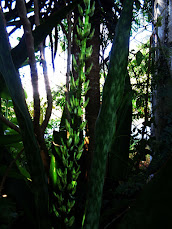















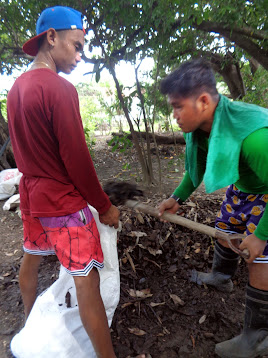

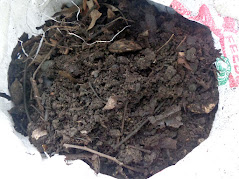































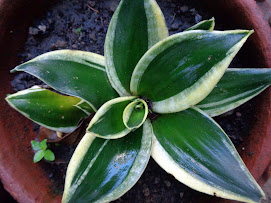










































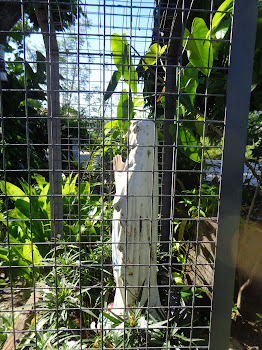










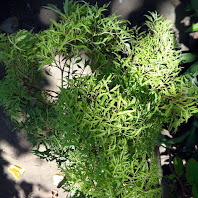


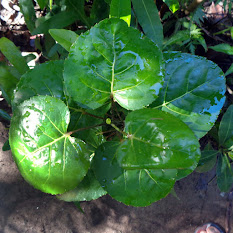




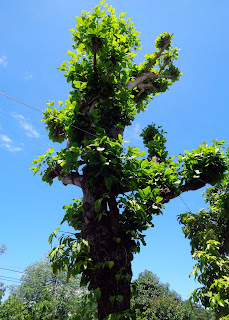

















.JPG)








No comments:
Post a Comment